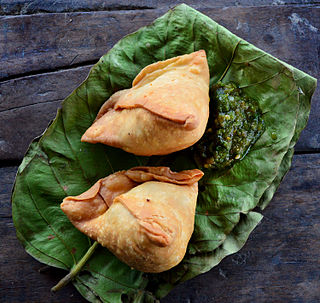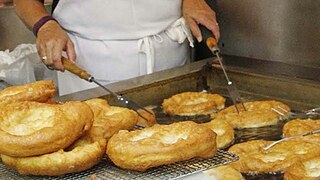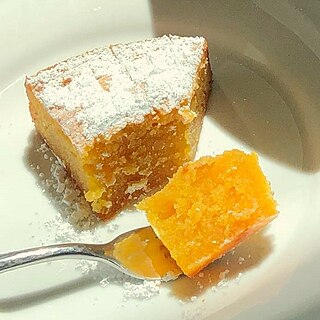
Brazilian cuisine is the set of cooking practices and traditions of Brazil, and is characterized by European, Amerindian, African, and Asian influences. It varies greatly by region, reflecting the country's mix of native and immigrant populations, and its continental size as well. This has created a national cuisine marked by the preservation of regional differences.

A churro is a type of fried dough from Spanish and Portuguese cuisine, made with choux pastry dough piped into hot oil with a piping bag and large closed star tip or similar shape. They are also found in Latin American cuisine, Philippine cuisine and in other areas that have received immigration from Spanish and Portuguese-speaking countries, especially in France and the Southwestern United States.

An empanada is a type of baked or fried turnover consisting of pastry and filling, common in Spain, other Southern European countries, North African countries, Latin American countries, and the Philippines. The name comes from the Spanish empanar, and translates as 'breaded', that is, wrapped or coated in bread. They are made by folding dough over a filling, which may consist of meat, cheese, tomato, corn, or other ingredients, and then cooking the resulting turnover, either by baking or frying.

A samosa from the Persian word sambosag (سنبوسگ) is a fried South Asian and West Asian snack. It is a pastry with a savory filling, mostly vegetables, spiced potatoes, onions, and peas, but also meat or fish. It is made in different shapes, including triangular, cone, or crescent, depending on the region. Samosas are often accompanied by chutney, and have origins in medieval times or earlier. Sweet versions are also made. Samosas are a popular entrée, appetizer, or snack in the cuisines of India, South Asia, West Asia, Central Asia, East Africa and their South Asian diasporas.

The oldest known book on Portuguese cuisine, entitled Livro de Cozinha da Infanta D. Maria de Portugal, from the 16th century, describes many popular dishes of meat, fish, poultry and others.

A turnover is a type of pastry made by placing a filling on a piece of dough, folding the dough over, sealing it, and then baking or frying it. Turnovers can be sweet or savoury and are often made as a sort of portable meal or dessert. They are often eaten for breakfast.

A curry puff is a snack of Southeast Asian origin. It is a small pie consisting of curry with chicken and potatoes in a fried or baked pastry shell. The consistency of the curry is quite thick to prevent it from oozing out of the snack. Pap or puff reflects the Fujian Chinese dialect 泡 ('pop'), which means 'bubble, blister, puffed'. It contains influences from Indian, Malay and Chinese cuisines.

Kue are bite-sized snacks or desserts originally from what is now Indonesia but have since spread throughout Southeast Asia. Kue is a fairly broad term in Indonesian to describe a wide variety of snacks including cakes, cookies, fritters, pies, scones, and patisserie. Kue are made from a variety of ingredients in various forms; some are steamed, fried or baked. They are popular snacks in Indonesia, which has the largest variety of kue. Because of the countries' historical colonial ties, Koeé (kue) is also popular in the Netherlands.

Malassada is a Portuguese fried pastry from the Azores. It is a type of doughnut, made of flattened rounds of yeasted dough, coated with sugar and cinnamon or accompanied with molasses.

Custard tarts or flan pâtissier/parisien are a baked pastry consisting of an outer pastry crust filled with egg custard.
Pastel is the Spanish and Portuguese word for pastry, a sugary food, and is the name given to different typical dishes of various countries where those languages are spoken. In Mexico, pastel typically means cake, as with Pastel de tres leches. However, in different Latin American countries pastel can refer to very different sugary dishes, and even to non-sugary ones as well. In some places, like Brazil, a pastel can refer to both a sugary and non-sugary food, depending on the filling used.

Dumpling is a broad class of dishes that consist of pieces of cooked dough, often wrapped around a filling. The dough can be based on bread, wheat or other flours, or potatoes, and it may be filled with meat, fish, tofu, cheese, vegetables, or a combination. Dumplings may be prepared using a variety of cooking methods and are found in many world cuisines.

Spring rolls are rolled appetizers or dim sum commonly found in Chinese, Vietnamese and Southeast Asian cuisines. The kind of wrapper, fillings, and cooking technique used, as well as the name, vary considerably depending on the region's culture, though they are generally filled with vegetables.
Puf Böreği is a deep-fried turnover with a filling of ground or minced meat and onions or Turkish cheese and parsley, dill.

Doce de gila is a Portuguese fruit preserve made from the pulp of the Cucurbita ficifolia. It can be used as jam or as an ingredient in various desserts and pastries.

Toucinho do Céu is a Portuguese dessert made primarily of almonds, eggs, and sugar. While it is often described as a cake or tart, toucinho do céu remains largely free of flour and should not be mistaken for other Portuguese cakes and tarts containing almonds.

Barriga de freira is a traditional Portuguese sweet egg yolk-based pudding. The name is an idiom on the ingredients typically found in conventual sweets made by the religious sisters at convents historically―egg yolks, sugar, and almonds. Another variation of barriga de freira is served as a turnover or empanada using the same pudding for a filling.















